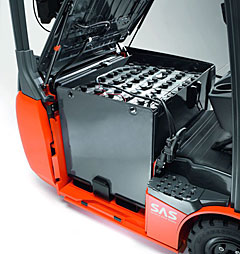
Industrial forklifts that are battery powered are used in an increasing variety of manufacturing and warehouse operations. Today’s electric batteries provide benefits like reduced emission, which helps many businesses (from small, family-owned groups to large corporations), achieve “green” goals regarding environmental responsibility. The other obvious benefits of today’s electric lift trucks are longer running times and shorter periods for recharging.
Battery powered lift trucks include small pallet trucks and large forklifts. Regardless of the lift truck make and model, operators and maintenance providers must be aware of the potential dangers when handling batteries. Observing some simple safety tips could prevent an accident from harming a worker.
There are two kinds of batteries in industrial forklifts, nickel-iron and lead acid. Either one can cause a safety risk if handled improperly. Operators who change out their own truck’s batteries, just like maintenance workers responsible for an entire fleet, must be cautious of the battery’s weight, the volatility of gas emissions when charging, and the danger of the corrosive chemicals inside batteries.
It’s important that businesses using battery powered lift trucks provide well-ventilated, clean, safe areas for use as battery changing stations and safety equipment to lessen the chance of a battery-related accident.
The installation area should be designated before a lift truck rolls out, with operators and supervisors alike understanding the purpose and location of the changing station(s). If your business, factory or warehouse isn’t completely smoke-free already, changing stations must become “no-smoking” zones, and must be clearly designated as such. Forklifts must be stationary, with the engine off and handbrake on, before any attempt to change a battery. Employees who are charging up and/or exchanging lift truck batteries must wear protective clothing.
To keep the designated battery changing areas safe, equipment and facilities should be close on-hand in case of chemical spills or fire. Your charging equipment – usually expensive to replace – should be adequately protected from these potential hazards, too. Material handling equipment like a conveyor or overhead hoist can prevent back injuries caused by lifting the heavy batteries. Another example is a flushing station, which allows workers to wash hands and eyes. Typical eyewash stations will provide enough supply for 15 minutes of free flowing water. Large locations should include a plumbed drench shower with the eyewash.
Training employees just in case these accidents occur makes good sense. If a lift truck operator, mechanic or maintenance crew member is certified in First Aid, for example, they will be more prepared to assess and deal with a fire, spilled battery acid or related injuries.
